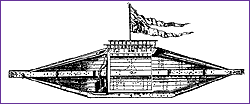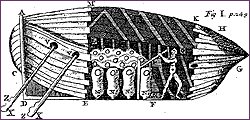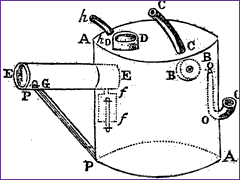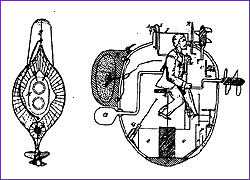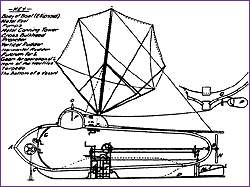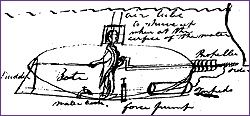 |

|
400 Years of Subs Introduction | 1580-1861 | 1861-1900 |1900-1918 1918-1939 | 1939-1945 | 1945-1972 | 1972-2000 1580 William Bourne, an English innkeeper and scientific dilettante, provided the first published prescription for a submarine. Bourne first offered a lucid description of why a ship floats—by displacing its weight of water—and then described a mechanism by which It is possible to make a Ship or Boate that may goe under the water unto the bottome, and so to come up again at your pleasure. [If] [a]ny magnitude of body that is in the water . . . having alwaies but one weight, may be made bigger or lesser, then it shall swimme when you would, and sinke when you list.... 1623 Dutchman Cornelius Drebbel, hired in 1603 as "court inventor" for James I of England, built what seems to have been the first working submarine. According to accounts, some of which people who actually saw the submarine may have written, it was a decked-over rowboat propelled by twelve oarsmen and made a submerged journey down the Thames River at a depth of about 15 feet. Neither credible illustrations of Drebbel's boat nor credible explanations of how it worked exist. Best guess: The vessel was designed to have almost-neutral buoyancy, floating just awash, with a downward-sloping foredeck to act as a sort of diving plane. The boat would be driven under the surface by forward momentum (as are most modern submarines). When the rowers stopped rowing, the craft would slowly rise. Reports that Drebbel's patron, James I, witnessed a demonstration may be true, but those claiming the king took an underwater ride are most unlikely. 1634 French priest Marin Mersenne theorized that a submarine should be made of copper and cylindrical in shape to better withstand water pressure (which increases about half a pound per square inch for every foot of depth). Such a craft, he maintained, should also bear pointed ends for streamlining and to permit course reversal without having to turn around.
The 72-foot-long Rotterdam Boat, designed by a man named De Son (a Frenchman), was probably the first underwater vessel specifically built (by Belgians) to attack an enemy (the English Navy). De Son meant for his almost-submarine—a semi-submerged ram—to sneak up unobserved and punch a hole in an enemy ship. He boasted that it could cross the English Channel and back in a day, and sink a hundred ships along the way. Propulsion: a spring-driven clockwork device that turned a central paddle wheel. The device was so underpowered, however, that when the boat was finally launched, it went—literally—nowhere.
No evidence exists that Italian Giovanni Borelli ever built a submarine, but this illustration and several variations continue to appear in books and magazines as if it had been a real boat, sometimes erroneously linked with the efforts of Drebbel (1623) or Symons (1729). Borelli did understand the basic principle of volume versus weight (displacement), but he illustrated a totally impractical ballast system in which an operator would increase the boat's weight by allowing a bank of goatskin bags to fill with water, then decrease it by squeezing the water out and enabling the vessel to rise again. 1696 Professor of mathematics Denis Papin built two submarines. He used an air pump to balance internal pressure with external water pressure, thus adjusting buoyancy by controlling the in-and-out flow of water into the hull. Propulsion: sails on the surface, oars underwater. Papin described "certain holes" through which the operator might "touch enemy vessels and ruin them in sundry ways." 1729 English house-carpenter Nathaniel Symons created a one-man expanding/contracting sinking boat (no locomotion) as a sort of public entertainment. Sealed up inside, in front of a crowd of spectators, he cranked the two parts of his telescopic hull together, spent 45 minutes underwater, then expanded the hull, rose to the surface, and passed the hat. One man gave him a coin. 1773 Wagonmaker J. Day, another Englishman, built a small submarine with detachable ballast: stones hung around the outside with ring bolts that one could release from inside. This worked quite well in shallow water. Encouraged by a professional gambler, Day built a bigger boat and offered spectators the opportunity to place bets on how long he could remain underwater farther out in the harbor. Surrounded by ships filled with bettors, Day's associates hung some stones; the boat wallowed awash but would not go under. They hung more stones, and this time the boat sank like a rock. Though no one could prove it, the vessel would have collapsed long before a frantic Day and his men could have released the ballast. All hands were lost. 1776 Yale graduate David Bushnell ('75) built the first submarine to actually make an attack on an enemy warship. Dubbed the Turtle for its resemblance to a sea turtle floating vertically in the water, the craft was operated by one Sergeant Ezra Lee. The plan was for Lee to be towed close to an enemy ship, open a foot-operated valve to let in enough water to sink, close the valve, and move in under the target. He would do so by cranking two propellers—one for forward and the other for vertical movement—by using a foot treadle "like a spinning wheel." He would then drill into the hull to attach a 150-pound keg of gunpowder with a clockwork detonator, crank to get away, and operate a foot pump to get the water out of the hull and re-surface. In early-morning darkness on September 7, 1776, Turtle made an attack on a British ship in New York harbor, probably HMS Eagle. The drill may have hit an iron strap, for it failed to penetrate the hull. (Contrary to most reports, the Eagle of 1776 did not have a copper-sheathed bottom.) Lee became disoriented and soon bobbed to the surface. Though a lookout spotted him, he managed to get away. 1797 Robert Fulton, a marginal American artist but increasingly successful inventor living in Paris, offered to build the French government a submarine for use against Britain. Fulton called it "a Mechanical Nautilus. A Machine which flatters me with much hope of being Able to Annihilate their Navy." He would build and operate the machine at his own expense and would expect payment for each British ship destroyed. Fulton predicted that "Should some vessels of war be destroyed by means so novel, so hidden, and so incalculable, the confidence of the seamen will vanish and the fleet [be] rendered useless from the moment of the first terror." 1800 After protracted delays and several changes in government, Fulton felt encouraged enough to build the submarine he called Nautilus. He made a number of successful dives, reaching depths of 25 feet and on one occasion staying down for as long as six hours, with ventilation on that excursion provided by a tube to the surface. Nautilus was essentially an elongated Turtle with a larger propeller and a mast and sail for use on the surface. In trials, Nautilus achieved a maximum sustained underwater speed of four knots. Given the rank of rear admiral, Fulton made several attempts to attack English ships, which saw him coming and simply moved out of the way. Fulton also attached the name 'torpedo' to that maritime weapon we now call a mine. Fulton's torpedoes were meant to be towed into position, either by a submerged boat or a surface rowboat. When the French passed on the Nautilus, he offered to sell torpedoes to the English, demonstrating their utility by sinking an anchored ship with a pair of torpedoes towed into place by a rowboat. 1812-1815 At least two submarines reportedly operated during the War of 1812. A British admiral called one of them "a Turtle," though assertions that Bushnell himself "returned to the charge" in the War of 1812 are not true. By that time, Bushnell, whose family had not heard from him for more than 25 years, was in his 70s and living under an assumed name in Georgia. The other submarine survives only in the notebooks of the revolver king Samuel Colt. The notebooks (now in the collection of the Connecticut Historical Society) show a design attributed to Silas Clowden Halsey. Colt added the notation "lost in New London harbor in an effort to blow up a British 74." Of this craft, nothing else is known. 1815 Englishman Thomas Johnstone may (or may not) have participated in Fulton's efforts on behalf of the French and may (or may not) have been hired to build a 100-foot-long submarine to be used in a planned rescue of Napoleon Bonaparte from exile on Elba. Whatever the facts of the case, Napoleon died before the (possible) submarine could be finished. 1850 While the Danish Navy was blockading the German port of Kiel, Prussian army corporal Wilhelm Bauer persuaded a shipbuilder to construct a blockade-breaking submarine based on his design. Bauer called his brainchild Brandtaucher (Incendiary Diver). About the size and shape of a small sperm whale, the boat was made of riveted sheet iron. Two men powered a treadmill to drive a propeller, while a third man steered. The crew controlled buoyancy with ballast tanks and adjusted trim by moving a sliding weight along an iron rod.
1852 Indiana shoemaker Lodner D. Phillips built at least two submarines. The first, which he constructed in 1845 at the age of 20, collapsed at a depth of 20 feet. The second achieved hand-cranked underwater speeds of four knots and depths of 100 feet. Phillips offered to sell it to the U.S. Navy, which promptly responded, "No authority is known to this Bureau to purchase a submarine boat . . . the boats used by the Navy go on not under the water." During the Civil War, he again offered his services to the Navy, again without success. 1855 Wilhelm Bauer built the 52-foot Diable Marin (Sea Devil) for Russia. The submarine made as many as 134 dives, the most spectacular of which celebrated the coronation of Tsar Alexander II. Of the 16 men the boat took underwater, four formed a brass band, whose underwater rendition of the national anthem could be heard clearly by listeners on the surface. 1859 French designer Brutus de Villeroi built a 33-foot-long treasure-hunting submarine for Philadelphia financier Stephen Girard. The target: the wreck of the British warship De Braak, lost near the mouth of the Delaware River in 1780. The method: divers operating out of an airlock. The boat made at least one three-hour dive to 20 feet; no other details are known. Continue: 1861-1900 Tour U-869 | Sole Survivor | Hazards of Diving Deep 400 Years of Subs | Map of Lost U-Boats | Fire a Torpedo Resources | Transcript | Site Map | Hitler's Lost Sub Home Editor's Picks | Previous Sites | Join Us/E-mail | TV/Web Schedule About NOVA | Teachers | Site Map | Shop | Jobs | Search | To print PBS Online | NOVA Online | WGBH © | Updated November 2000 |

